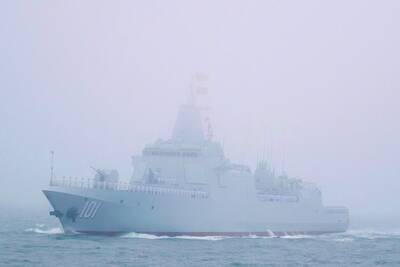An Australian filmmaker plans to swim across the Pacific Ocean from Japan to the US in a giant plastic bottle, plowing through a huge floating garbage dump to highlight marine pollution.
Richard Pain said he realized that swimming 9,000km from Japan to California was “completely mad,” but said he hoped it inspired others to think more about the environment.
“If I can do something this crazy, everybody else can do something,” he said on Friday. “Whether it’s recycle, reuse, rethink, stop using single use plastics ... just change their behavior in some simple way.”
Pain, 45, plans to swim in a giant recycled plastic water bottle made out of thousands of smaller plastic water bottles. The structure, which he said is under design, is intended to protect him from the hazards of the ocean.
“All the small bottles will be in the shape of one big bottle,” he said. “I’m trying to create the iconic media image ... a man swimming in the middle of the Pacific Ocean inside a giant plastic water bottle.”
Pain said his journey would take him through what is known as the North Pacific Gyre or the Great Pacific Garbage Patch — an area twice the size of Texas full of plastic garbage to a depth of about 6m.
Because of four competing ocean currents that operate in a clockwise direction, the garbage thrown off ships and blown off land has accumulated in a becalmed area in the center, posing risks to birds and marine life.
The area is “choked” with plastic items, which can be sponges for toxins, varying in size from a kayak to the tiniest wisps of plastic, Pain said.
“To the eye as you look across it, it undulates like regular ocean, but when you look down into it, yeah, it’s just plastic everywhere,” he said. “It’s ocean, but it’s kind of like soupy ocean.”
Pain, who plans to embark on his trip in 2011, said he would swim up to 10 hours a day, five days a week and spend his weekends recovering onboard a ship following his course.

ELECTION DISTRACTION? When attention shifted away from the fight against the militants to politics, losses and setbacks in the battlefield increased, an analyst said Recent clashes in Somalia’s semi-autonomous Jubaland region are alarming experts, exposing cracks in the country’s federal system and creating an opening for militant group al-Shabaab to gain ground. Following years of conflict, Somalia is a loose federation of five semi-autonomous member states — Puntland, Jubaland, Galmudug, Hirshabelle and South West — that maintain often fractious relations with the central government in the capital, Mogadishu. However, ahead of elections next year, Somalia has sought to assert control over its member states, which security analysts said has created gaps for al-Shabaab infiltration. Last week, two Somalian soldiers were killed in clashes between pro-government forces and

Ten cheetah cubs held in captivity since birth and destined for international wildlife trade markets have been rescued in Somaliland, a breakaway region of Somalia. They were all in stable condition despite all of them having been undernourished and limping due to being tied in captivity for months, said Laurie Marker, founder of the Cheetah Conservation Fund, which is caring for the cubs. One eight-month-old cub was unable to walk after been tied up for six months, while a five-month-old was “very malnourished [a bag of bones], with sores all over her body and full of botfly maggots which are under the

BRUSHED OFF: An ambassador to Australia previously said that Beijing does not see a reason to apologize for its naval exercises and military maneuvers in international areas China set off alarm bells in New Zealand when it dispatched powerful warships on unprecedented missions in the South Pacific without explanation, military documents showed. Beijing has spent years expanding its reach in the southern Pacific Ocean, courting island nations with new hospitals, freshly paved roads and generous offers of climate aid. However, these diplomatic efforts have increasingly been accompanied by more overt displays of military power. Three Chinese warships sailed the Tasman Sea between Australia and New Zealand in February, the first time such a task group had been sighted in those waters. “We have never seen vessels with this capability

‘NO INTEGRITY’: The chief judge expressed concern over how the sentence would be perceived given that military detention is believed to be easier than civilian prison A military court yesterday sentenced a New Zealand soldier to two years’ detention for attempting to spy for a foreign power. The soldier, whose name has been suppressed, admitted to attempted espionage, accessing a computer system for a dishonest purpose and knowingly possessing an objectionable publication. He was ordered into military detention at Burnham Military Camp near Christchurch and would be dismissed from the New Zealand Defence Force at the end of his sentence. His admission and its acceptance by the court marked the first spying conviction in New Zealand’s history. The soldier would be paid at half his previous rate until his dismissal